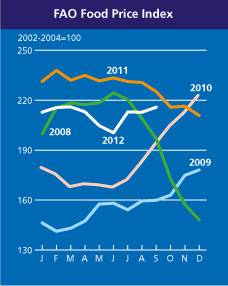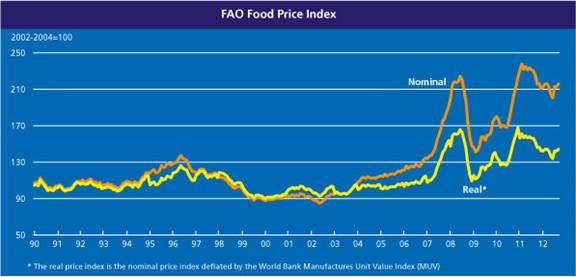September Saw World Food Prices Rising
By Countercurrents.org
05 October 2012
Countercurrents.org
World food prices rose in September. The prices are close to levels reached during the 2008 food crisis. FAO has cut its forecast for global cereal output.
The FAO Food Price Index rose slightly in September 2012, up 1.4 percent, or 3 points, from its level in August. The rise reflected strengthening dairy and meat prices and more contained increases for cereals. Prices of sugar and oils, on the other hand, fell [1].
The FAO Index currently stands 22 points below its peak of 238 points in February 2011, and 9 points below its level of 225 points in September 2011.
The FAO Cereal Price Index averaged 263 points in September, 1.0 percent, or 3 points up from August, as gains in wheat and rice prices offset a decline in maize. While shrinking maize export availabilities and high maize prices have been leading cereal markets in recent months, tightening wheat supplies have also become a concern.
International wheat prices fell towards the second half of the month, following the announcement by the Russian Federation that it would not impose restrictions on exports.
The FAO Meat Price Index averaged 175 points in September, up 2.1 percent, or 4 points, from August.
The FAO Dairy Price Index averaged 188 points in September, up 7 percent, or 12 points, from August, representing the sharpest monthly increase since January 2011. All the five dairy products monitored saw prices rise.
FAO's latest forecasts confirm a decline in global cereal production this year from the record registered in 2011. But record harvests are expected in Low-Income Food-Deficit Countries (LIFDCs). The forecast for the LIFDCs' 2012 aggregate cereal production points to a record level of 534 million tones, up 1.7 percent from the good harvest of 2011. Excluding India , the largest country in this group which is expected to see a stagnant total cereal harvest this year, the aggregate cereal output of the remaining 65 LIFDCs is estimated to expand by 2.9 percent.
World cereal production in 2012 is now forecast at 2 286 million tones, slightly down from the 2 295 million tones estimated in September, according to the new issue of FAO's quarterly Crop Prospects and Food Situation report also published on October 4, 2012.
At the currently forecast level, world cereal production in 2012 would be 2.6 percent down from the previous year's record crop but close to the second largest in 2008. The overall decrease comprises a 5.2 percent reduction in wheat production and a 2.3 percent reduction for coarse grains.
This is expected to result in a significant reduction in world cereal stocks by the close of seasons in 2013 (down by 28 million tones to 499 million tones), even with world demand sliding as a result of high prices. Production has been affected by drought in key producing areas such as the United States , Europe and Central Asia .
However, very early indications for wheat crops in 2013 are encouraging, with winter wheat planting in the northern hemisphere already well advanced under generally favorable weather conditions.
The present high prices are expected to drive the 2012/13 cereal import bill for LIFDCs to a record $36.5 billion, compared to $35.2 billion in 2011/12.
In West Asia , deteriorating food security amid civil unrest continues to be a major concern in Syria and Yemen . In Syria , the number of people in need of urgent food assistance has increased to 1.5 million and could double by the end of the year if the current situation does not improve. In Yemen , ten million people, or nearly half of the population, are estimated to be in need of emergency food assistance as a result of high levels of poverty, prolonged conflict and high food and fuel prices. But in Afghanistan , a bumper wheat harvest has been gathered.


Source: FAO
From Rome , a Reuters report [2] said:
The worst drought in more than 50 years in the US sent corn and soybean prices to record highs over the summer, and, coupled with drought in Russia and other Black Sea exporting countries, raised fears of a renewed crisis.
Grains prices have retreated in recent weeks due to rapid harvest progress and concerns about weak demand in a slowing global economy.
But the FAO price index rose 1.4 percent to an average of 216 points in September after remaining stable at 213 points in August. The rise reflected mainly higher dairy and meat prices, with more contained increases for cereals.
"Prices are remaining high... prices are sustained, it's highly unlikely we will see a normalization of prices anytime soon," FAO senior economist Abdolreza Abbassian told Reuters in a telephone interview.
He added however that it was not clear whether the small increase in September meant prices were now on an upward trend, but he expected volatility in markets could intensify in coming months.
Aid agency Oxfam called on governments to tackle the root causes of food price volatility.
French President Francois Hollande has launched a global campaign to win support for strategic stocks of agricultural commodities, but EU development Commissioner Andris Piebalgs said this week that was not the best way to tame food prices, advising a focus on agricultural investment to boost production.
Source :
[1] Commoditiesnow.com , “FAO Food Price Index up 1.4 percent in September”, Rome , October 4, 2012
[2] Catherine Hornby, “World food prices rise, stay close to crisis levels: UN”,
http://news.yahoo.com/world-food-prices-edge-sept-fao-083133718.html
Comments are moderated


